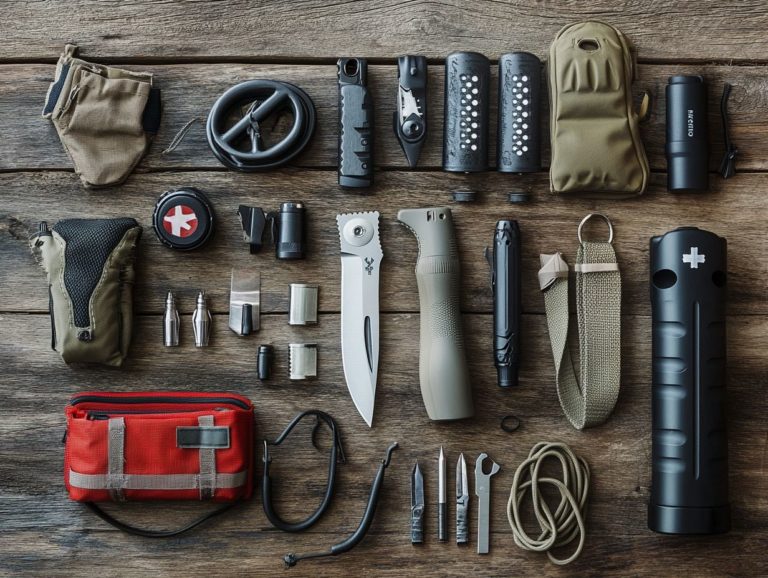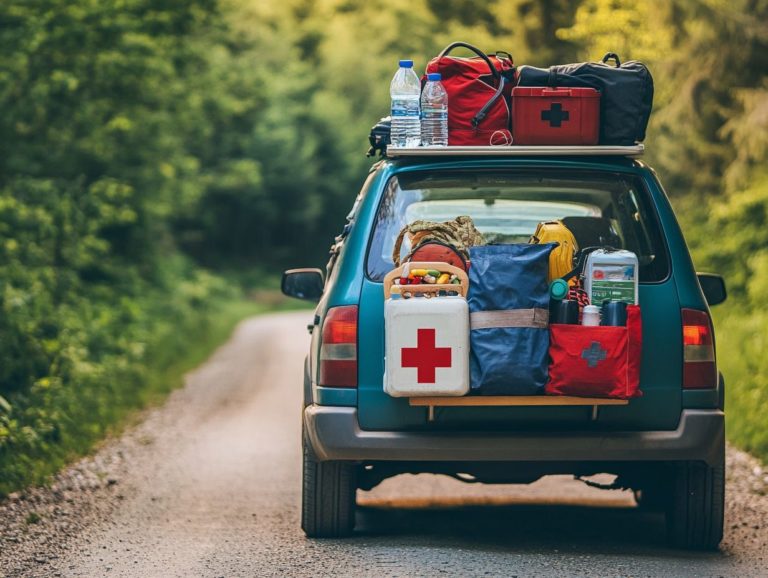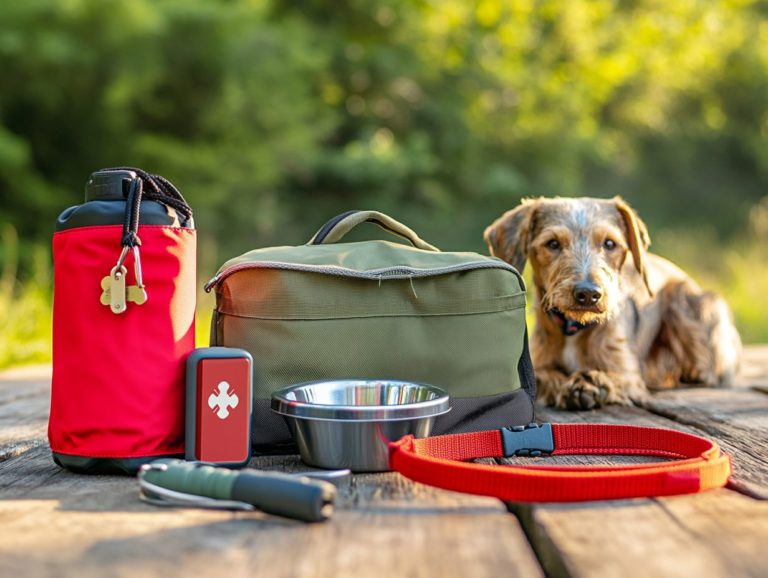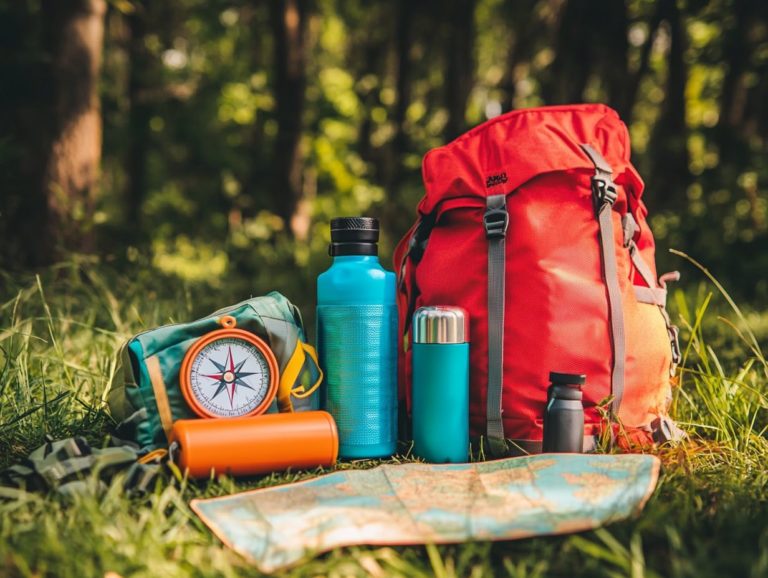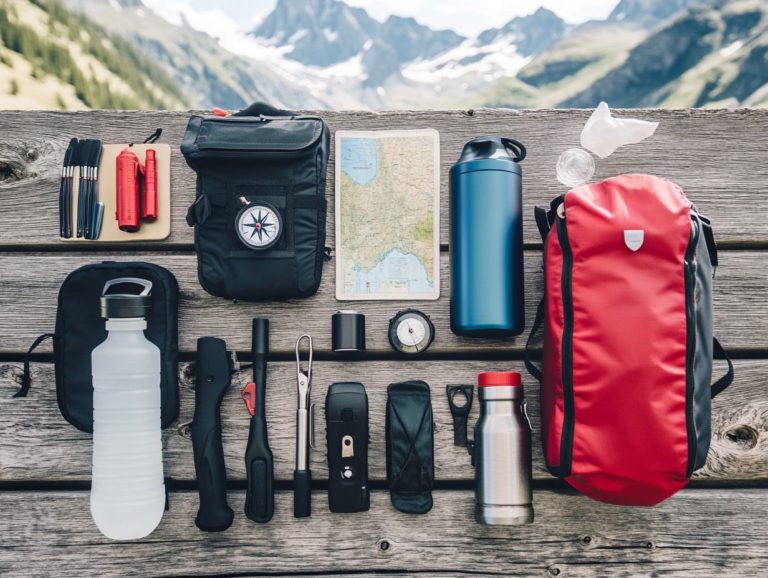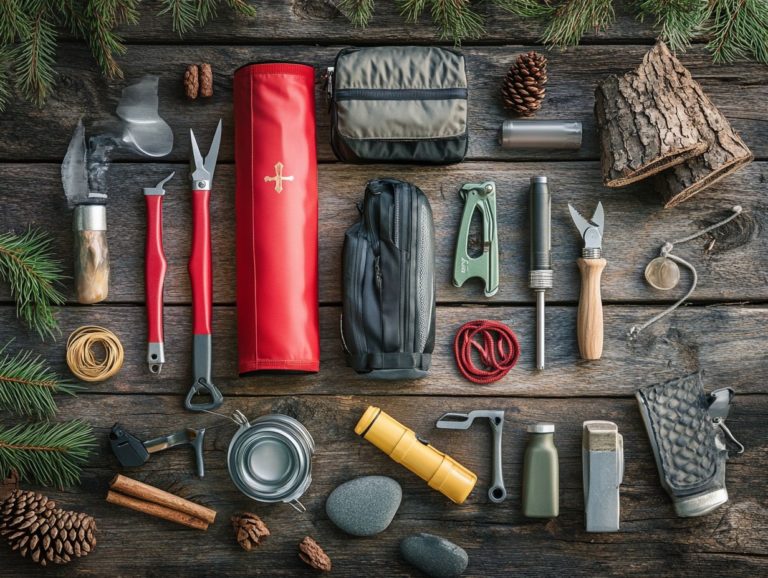Survival Gear for the Inexperienced Hiker
Heading into the great outdoors can be an exhilarating experience, but preparation for the unexpected is essential, especially when considering your hiking survival kit.
Whether you re a seasoned adventurer or just starting your hiking journey, having the right survival gear can make a huge difference in your outdoor adventures. Get ready to discover the must-have items for your hiking survival kit everything from navigation tools to emergency communication devices.
You ll gain insights on how to customize your gear for specific weather conditions and avoid common packing mistakes, ensuring a safer and more enjoyable hiking experience.
Prepare to equip yourself for your next hiking adventure!
Contents
- Key Takeaways:
- 1. Navigation Tools and Techniques
- 2. First Aid Kit
- 3. Shelter
- 4. Water and Water Purification Tools
- 5. Fire Starting Tools
- 6. Food and Cooking Tools
- 7. Multi-Tool
- 8. Emergency Communication Device
- 9. Extra Clothing and Protective Gear
- 10. Headlamp or Flashlight
- 11. Personal Locator Beacon
- 12. Bear Spray
- 13. Emergency Whistle
- 14. Map and Compass
- 15. Survival Guide or Manual
- What Are the Essential Items for a Hiking Survival Kit?
- Frequently Asked Questions
- 1. What is considered essential survival gear for inexperienced hikers?
- 2. Can I rely solely on my phone for navigation during a hike?
- 3. What type of emergency shelter and lightweight gear should I bring?
- 4. Do I need a multi-tool for hiking?
- 5. How much food and water should I bring for a hike?
- 6. What should I do if I get lost during a hike?
Key Takeaways:
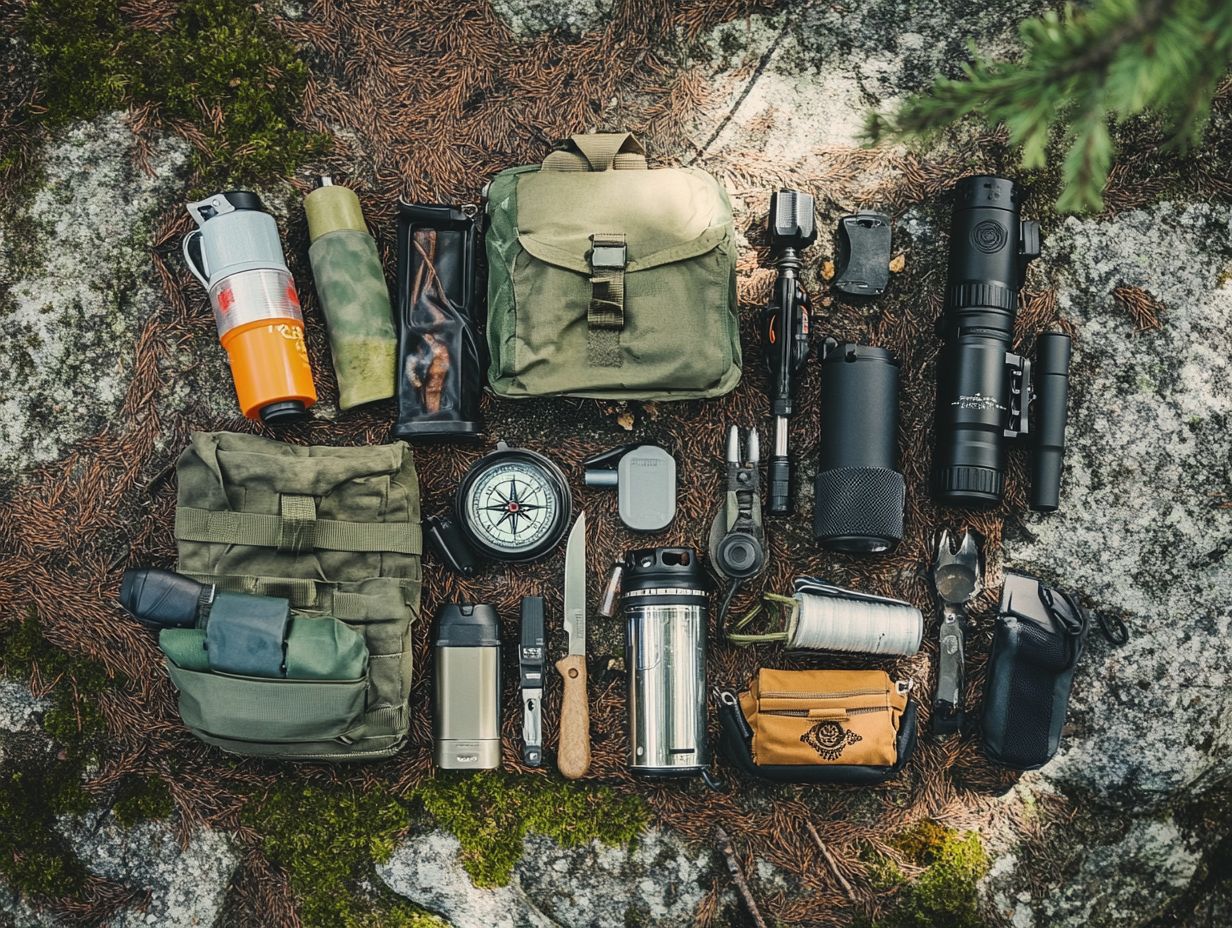
- Always carry a map and compass to avoid getting lost in the wilderness.
- A well-stocked first aid kit, like the Surviveware Small First Aid Kit, can be a lifesaver for unexpected injuries on the trail.
- Proper shelter, such as a tent or emergency blanket, is crucial for protection against the elements.
Navigation tools are essential for your outdoor adventures, allowing you to orient yourself and navigate various terrains, from the majestic Canadian Rockies to the breathtaking Alps. These tools enhance your hiking experience and significantly reduce the risks of getting lost.
Whether you choose traditional instruments like the BIJIA Orienteering Map Compass and the Brunton TruArc 7 Compass, or advanced technology such as the Garmin inReach Mini 2, each tool boosts your confidence as a hiker. Traditional tools help with directions based on maps and natural landmarks.
On the other hand, modern GPS devices allow you to find out where you are right away and provide emergency communication capabilities.
This blend of timeless wisdom and cutting-edge technology ensures you re well-prepared and ready for any unexpected challenges that may arise.
2. First Aid Kit
A well-equipped first aid kit, like the Surviveware Small First Aid Kit, is essential for your hiking survival kit. It s ready to tackle various injuries and emergencies that may occur during your outdoor adventures.
When preparing this kit, consider the unique challenges each hiking trip presents. Factors such as the environment, duration, and the size of your group will determine your specific needs.
Include essentials like bandages and antiseptic wipes, but also think about adding items like a splint, blister treatment, and pain relief medication. Knowing how to use each item effectively like applying a pressure bandage for severe bleeding can significantly improve your response in emergencies.
Enhancing your kit with outdoor safety items like an emergency whistle, headlamp, and multi-tool ensures you re ready for medical scenarios and any other unexpected challenges that may arise in the wilderness.
3. Shelter
Having a reliable shelter, like the TACT Bivvy, is crucial for protecting yourself against the elements during your hiking adventures. This is especially true in rugged terrains where conditions can change rapidly. The right shelter keeps you safe and comfortable.
Besides bivvy bags, you can explore other shelter options like tents and tarps, each offering unique benefits. Tents provide spacious interiors and added privacy, making them great for group camping or extended stays.
On the flip side, tarps are lightweight and incredibly versatile, allowing for quick setup and adaptability against rain or sun.
Recognizing the importance of these shelters is vital; they play a critical role in comfort and safety during unexpected overnight situations or adverse weather. Whether faced with a sudden storm or a chilly night, the right shelter can greatly enhance your outdoor experience.
4. Water and Water Purification Tools
Access to clean water is essential during hiking. Tools like the Lifestraw Universal and purification tablets are crucial for outdoor survival.
Staying hydrated boosts your physical performance and enhances your overall well-being, especially in challenging environments. You should plan your water supply by using packs designed to carry water comfortably. These packs often have built-in reservoirs, allowing you to sip water on the go without pausing your journey.
Incorporating purification methods lets you easily draw from natural water sources like streams or lakes. With efficient hydration systems and reliable purification techniques, you can stay energized and safe out there, avoiding dehydration while embracing the beauty of the great outdoors.
5. Fire Starting Tools
Fire starters are essential for hikers. They allow you to create a campfire for warmth, cooking, and signaling during emergencies. Tools such as berleben Z nden and waterproof matches are reliable options.
Embracing traditional methods, like flint and steel or bow drills, sharpens your skills and deepens your connection to nature. Modern tools like ferrocerium rods, which produce sparks to ignite fires, and magnesium blocks provide quick ignition even in bad weather.
Understanding the importance of fire goes beyond sustenance; it boosts morale, transforming your camping experience with warmth and comfort. Always build fires in designated areas, use dry tinder and kindling, and ensure you re prepared to extinguish the flames properly before leaving the site.
6. Food and Cooking Tools
Food and cooking tools are vital in a hiking survival kit. They maintain your nutrition and energy levels on outdoor adventures.
To optimize your sustenance on the trail, consider lightweight, non-perishable options like dehydrated meals, energy bars, and nuts. These choices are easy to pack and require minimal preparation, making your journey smoother.
For cooking, portable stoves or compact cooking systems are invaluable for safely preparing meals. You can easily boil water to rehydrate meals or use simple methods like grilling or frying over a small campfire.
Focusing on nutrition is crucial; a well-balanced diet fuels your body, enhancing stamina and recovery for an enjoyable hiking experience.
7. Multi-Tool
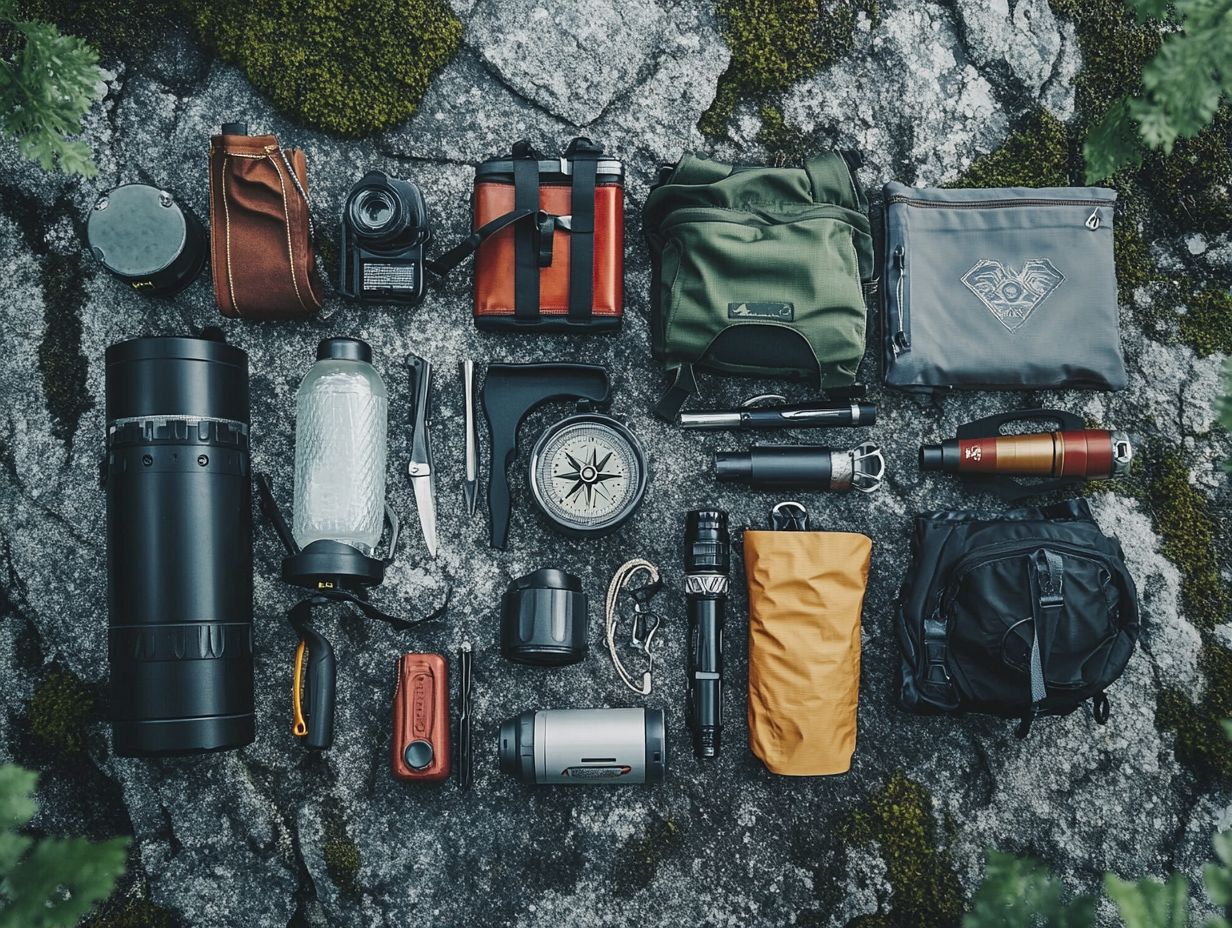
A durable multi-tool is essential for your hiking survival kit. It helps with tasks from gear repair to food preparation, enhancing your efficiency during outdoor excursions.
These compact devices can include pliers, knives, screwdrivers, and even bottle openers, making them invaluable in unpredictable natural settings. If you venture into rugged terrains, consider brands like Leatherman, known for robust models with specialized features for survival scenarios. Alternatively, Victorinox offers versatile options that blend utility with sleek design.
The Gerber Suspension, known for easy accessibility, is an excellent choice for navigating challenging trails and everyday situations. Such tools prepare you for emergencies and simplify daily tasks on the trail, making your adventures all the more enjoyable.
8. Emergency Communication Device
Having an emergency communication device, like a Fox 40 Sonik whistle or a satellite messenger, is crucial for your safety! These tools let you signal effectively and ensure seamless communication during emergencies in the wilderness.
Think of these devices as your lifelines. They allow you to reach out for help when it matters most. Their advantages go far beyond communication; they significantly boost your confidence and peace of mind as you navigate challenging terrains.
In situations like getting lost, getting hurt, or facing severe weather, knowing how to use these devices can mean the difference between a harrowing ordeal and a successful rescue. A whistle can alert nearby hikers without draining battery life. Meanwhile, a satellite messenger provides two-way communication, allowing you to share your location precisely.
Understanding how to use each device in various scenarios is crucial for any hiker eager to explore safely and responsibly.
9. Extra Clothing and Protective Gear
Packing extra clothing and protective gear is essential for your hiking safety, especially since weather conditions can shift quickly. Having lightweight gear on hand keeps you comfortable and helps prevent hypothermia, a dangerous drop in body temperature, in unexpected scenarios.
Layering with fabrics that pull moisture away from your body is a game changer. These materials regulate your body temperature and wick sweat away from your skin, minimizing that chilly feeling on a cool day. Adding a lightweight waterproof jacket to your gear ensures that sudden rain showers won’t derail your hike.
In colder environments, thermal items like insulated gloves and hats are crucial, safeguarding your extremities from heat loss. Being well-prepared with the right clothing enhances your outdoor experience and significantly boosts your safety, allowing you to make quick adjustments as conditions change.
10. Headlamp or Flashlight
A reliable headlamp or flashlight is essential for your hiking safety, especially during early morning or late evening outings. They empower you to navigate effectively and confidently as daylight fades.
While both tools illuminate your path, headlamps have unique advantages that enhance your hiking experience. Their hands-free operation is invaluable when you need both hands to climb or set up a tent. Plus, with adjustable brightness settings, headlamps can adapt easily to various conditions, making them more versatile than traditional flashlights.
Many headlamps come with longer battery life, so you stay equipped without the worry of running out of power. When choosing the right lighting equipment for different terrains, consider factors like weight and durability to ensure the perfect choice for every adventure.
11. Personal Locator Beacon
A personal locator beacon is an essential device for hikers, acting as your lifeline in emergencies. It enables you to signal for help and share your location with rescue services.
These compact yet powerful devices work by transmitting a distress signal via satellite. This allows search and rescue teams to pinpoint your location with remarkable accuracy. They are crucial in remote or rugged terrains, where cell phone coverage may be nonexistent.
Whether you get hurt, lose your way, or encounter unexpected health issues, a personal locator beacon offers peace of mind and security. Different models come with various features like GPS accuracy, battery life, and durability so it’s vital for outdoor enthusiasts to select one that meets their specific needs.
If you find yourself in situations where two-way communication would be helpful, consider a satellite messenger. This device provides emergency signaling and lets you send updates to your loved ones, keeping them informed.
12. Bear Spray
Bear spray is an essential ally in your hiking safety toolkit, especially in regions where wildlife encounters are a possibility. It provides a reliable way to deter aggressive bears, ensuring your outdoor adventures are both thrilling and safe.
In popular destinations like Yellowstone and Glacier National Park, carrying bear spray is not just a smart choice; in fact, many parks require it for your safety! Familiarizing yourself with its operation can truly be a lifesaver in a tense moment. Practice removing the safety tab and aim downwind these small steps can make all the difference.
As you navigate these wild terrains, stay vigilant. Keep an eye out for bear tracks or scat to help steer clear of unexpected encounters. Traveling in groups and making noise enhances your experience and alerts wildlife to your presence, significantly lowering the chances of startling a bear and provoking an aggressive response.
13. Emergency Whistle
An emergency whistle is not just a lightweight accessory; it s an essential tool for your hiking safety. This small yet powerful device allows you to signal for help loudly and clearly over long distances when emergencies arise.
When your voice might strain or fail due to fatigue or anxiety, the whistle becomes a reliable alternative. Its piercing sound can travel much farther than your voice, easily cutting through dense foliage and noisy environments. For example, while trekking through wilderness areas, if you find yourself separated from your group or facing an unexpected situation, a few short blasts can effectively draw attention.
In scenarios where you might get lost or injured, a whistle saves your energy when every second counts! By incorporating an emergency whistle into your gear, you enhance your safety and boost your confidence in navigating the unpredictable conditions of the great outdoors. To further prepare for your adventures, consider checking out the best survival gear for day hikes.
14. Map and Compass
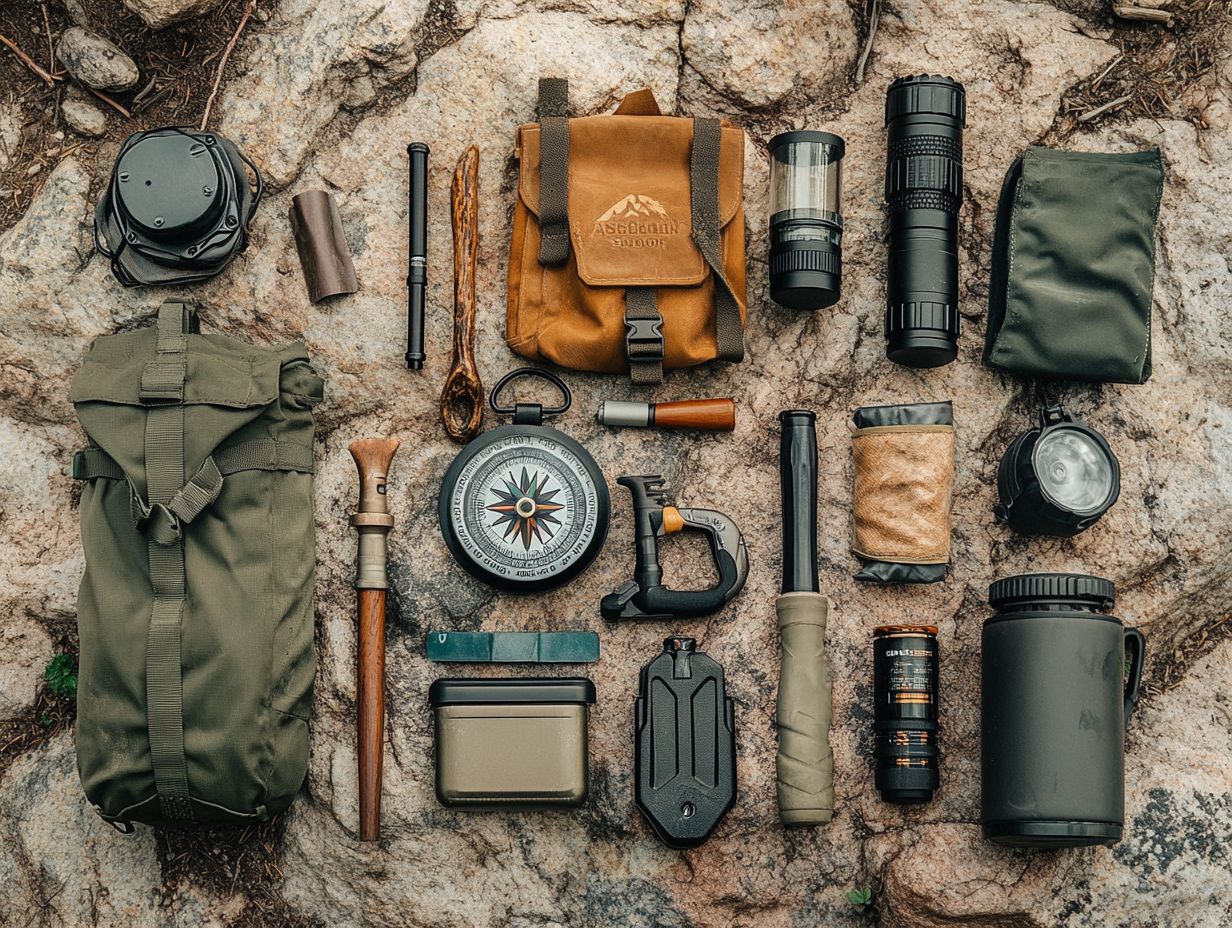
Using a map and compass as your navigation gear is an essential skill for hikers. It offers crucial guidance that enhances your overall hiking experience by helping you stay oriented in unfamiliar terrains.
Mastering the art of reading topographic maps, which show elevation and terrain features, and accurately interpreting compass bearings helps you gain a clearer understanding of your surroundings and the potential hazards ahead. Combining these two tools heightens your awareness of the environment and prepares you for unexpected shifts in weather or trail conditions.
Practicing these skills regularly in various settings builds your confidence. This knowledge equips you to navigate safely through wilderness areas, significantly reducing the risk of getting lost and elevating your enjoyment of outdoor adventures. To enhance your preparedness, consider checking out the top 5 survival gear kits for beginners.
15. Survival Guide or Manual
A survival guide or manual serves as an invaluable companion for hikers. It provides essential survival techniques along with a comprehensive checklist to ensure you’re fully prepared for outdoor adventures and potential emergencies.
Equipping yourself with this knowledge elevates your hiking experience and can be crucial in life-threatening situations. From grasping basic first aid principles, like treating cuts, bruises, or more serious injuries, to mastering navigation skills with a map and compass, the insights found in these guides, along with the best survival gear for backpackers, empower you with confidence and safety on the trail.
Learning how to construct effective shelters offers critical protection against unpredictable weather conditions. Having this information at your fingertips during hikes is essential, enabling you to respond adeptly to any unexpected challenges that may arise, especially if you have the top 10 survival gear for wilderness adventures on hand.
What Are the Essential Items for a Hiking Survival Kit?
A well-prepared hiking survival kit is essential for your outdoor adventures. It should be packed with necessary items like navigation tools, a first aid kit, and various survival supplies. These items ensure your safety and readiness for any emergency situation.
These tools become particularly critical when you encounter unexpected challenges, such as sudden weather shifts, injuries, or even the disorienting experience of getting lost. For instance, having the right survival gear for the wilderness can make all the difference. Take, for example, a reliable compass; it not only points you in the right direction but also helps you maintain your sense of orientation when trails become obscured.
A comprehensive first aid kit is essential for treating injuries ranging from minor cuts to more serious issues. Having this kit ensures you stay healthy and fully capable of completing your trek. Don’t overlook survival supplies like fire starters and emergency blankets, which offer warmth and security as night falls or when the weather takes a turn. For those venturing into the wild, consider the top 10 survival gear items for hikers to enhance your safety and preparedness.
Each component of this kit plays a vital role in improving your safety, ultimately contributing to a successful and enjoyable hiking experience. To ensure you’re fully equipped, refer to the ultimate checklist for hiking gear.
How Can One Determine What Gear Is Necessary for Their Hiking Trip?
Determining the gear necessary for your hiking trip involves weighing various factors. Consider your destination, the duration of your adventure, and weather conditions, while incorporating hiking tips and recommendations to ensure you’re well-prepared for the journey ahead.
The type of terrain whether it s rocky, muddy, or steep will significantly influence your gear choices. For instance, sturdy hiking boots are essential for navigating rough landscapes, while lightweight shoes may suffice for well-maintained trails.
The distance you plan to hike also plays a critical role; longer excursions will require more robust water systems like water bottles or hydration packs and ample snacks to keep your energy levels up.
When considering essential gear items, think about including:
- A first-aid kit,
- Navigation tools,
- Layered clothing.
All these should be thoughtfully curated with weight considerations to maintain your mobility and comfort on the trail. By carefully evaluating these factors, you can enhance your overall hiking experience and ensure safety throughout your adventure.
What Are Some Common Mistakes to Avoid When Packing for a Hike?
Avoiding common mistakes when packing for a hike is essential to enhance your overall experience. Improper packing can lead to unnecessary challenges, discomfort, and even safety risks during your outdoor adventures.
Be mindful of what you pack, or you might weigh yourself down! Overpacking can transform what should be an enjoyable trek into a grueling slog. Ignoring the weather conditions can also lead to serious discomfort, whether you’re underestimating the chill of an early morning or the likelihood of afternoon rain. To prepare effectively, consider investing in survival gear for the solo adventurer.
Don’t overlook the importance of packing essential items like sufficient water, snacks, and a basic first-aid kit. By organizing your gear thoughtfully and considering variable weather forecasts, you can be well-prepared for both the expected and the unexpected, ultimately enriching your outdoor experience.
What Are the Benefits of Bringing a Satellite Phone or GPS Device?
Bringing a satellite phone or GPS device on your hike offers a multitude of benefits, especially regarding your safety. These tools provide reliable communication and precise navigation capabilities, ensuring you’re equipped for any emergency situation.
With constant connectivity, you can stay in touch with loved ones, granting you peace of mind as you navigate through both remote terrains and popular trails. Should unexpected challenges arise like sudden weather shifts or injuries having quick access to rescue services can truly be a game-changer.
Imagine being caught in a storm; your satellite phone could be your lifeline to call for help, while a GPS device would guide rescuers right to your location. Numerous instances demonstrate how these technologies play a crucial role in wilderness emergencies, not just by keeping you connected but also by potentially saving lives.
How Can One Prepare for Different Weather Conditions?
Preparing for various weather conditions is vital for your hiking safety. Shifting climates can greatly influence your experience and the gear necessary for a successful outdoor adventure.
Before you set off, check the weather forecast. This helps you select the right gear.
If rain is looming, pack a reliable rain jacket and waterproof footwear. Staying dry keeps you comfortable!
If you re facing colder conditions, pack thermal layers and insulated gloves to prevent getting too cold. Customizing your packing list based on the weather enhances your comfort and reduces risks.
Frequently Asked Questions
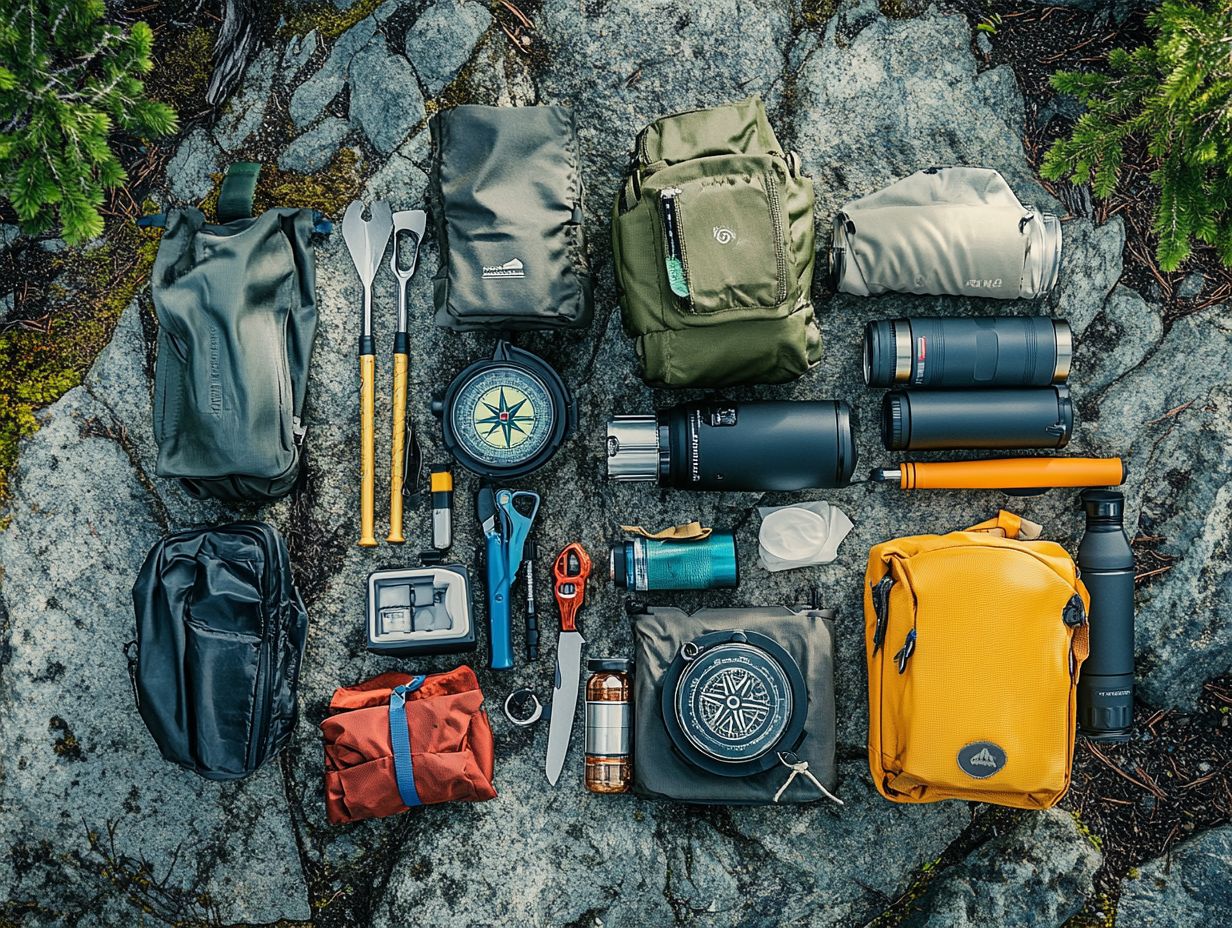
1. What is considered essential survival gear for inexperienced hikers?
Essential survival gear includes a map and compass, first aid kit, waterproof matches, a multi-tool, emergency shelter, and enough food and water for your hike.
It s not recommended to rely solely on your phone. Cell service may be unavailable in remote areas, and battery life can run out. Always bring a map and compass as a backup.
3. What type of emergency shelter and lightweight gear should I bring?
Lightweight tents or emergency bivvy bags are ideal. They offer protection from the elements and fit easily in a backpack.
4. Do I need a multi-tool for hiking?
A multi-tool is not necessary but can be very useful. It typically includes features like a knife, scissors, and pliers.
5. How much food and water should I bring for a hike?
Bring enough food and water for the duration of your hike, plus an extra day’s worth for emergencies. The amount can vary based on the hike’s length and difficulty.
6. What should I do if I get lost during a hike?
If you get lost, stay calm and assess your surroundings. Use your map and compass to find your way back. If you can’t, stay put and signal for help using a whistle or signal mirror.

